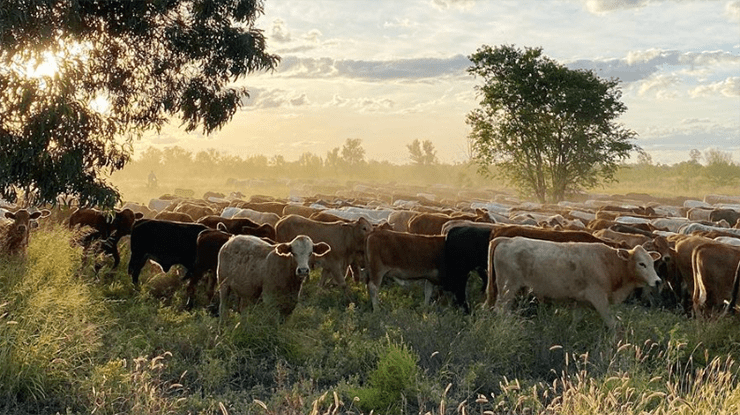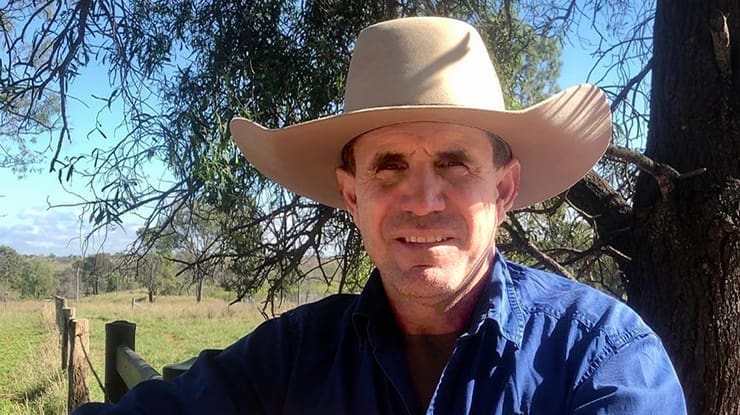
Weaners moving onto grower country cells on Andrew Mactaggart’s property near Duaringa, Central Queensland.
NORTHERN beef producers have two new tools at their disposal to drive fertility and genetic gain in their herds.
Genomic Breeding Values (GBVs) and herd profiling are designed to boost fertility in high-value commercial production systems.
They allow producers to identify high performing replacement females, for greater transparency in management decisions to fast-track productivity gains.
Benchmarking
Benchmarking is an important tool to identify opportunities to lift herd performance, but until recently, the ability to benchmark the genetic potential of commercial herds was limited.
An MLA project in partnership with the University of Queensland has closed the gap between possible genetic gains and the gains producers are currently achieving in northern beef production systems.
The project, which has just finished, used a large reference population to map a range of traits related to fertility.
MLA’s project manager for livestock genetics, Clara Bradford, said unlike previous models which focused on recording genetically diverse seedstock animals, the UQ project recorded phenotypes and genotypes of commercial herds.
The 54 collaborator herds involved in the project contributed 26,000 commercial females, which were recorded for age at puberty, return to oestrus (P4M) and other production traits, as well as new traits such as tick resistance.
“The aim was to provide a tool that could utilise the technology of genomics for commercial production systems, where they don’t have the level of recording or accuracy that a seedstock herd would,” she said.
Two products emerged from the project:
GBVs and herd profile
A Genetic Breeding Value (GBV) is a trait based off a genomic prediction developed from a large commercial reference population.
It allows producers to select commercial females that are better for fertility and growth, or teams of bulls from crossbred or composite breeds that are part of the reference.
While the products allow producers to test bulls, they don’t replace estimated breeding values (EBVs). However the GBVs can help producers select their highest performing heifers in a more objective way.
“If a breeder had to pick 20 heifers from 100, the GBVs allow them to select on their genetic potential for key fertility traits, instead of on pedigree, the way they look, or how much they weigh,” Ms Bradford said.
“It’s less subjective, more objective.”
Herd profile
If a producer has never done any form of genomic testing or used breeding values before, the new herd profile tool will benchmark where their herd sits.
“In a breed that has EBVs, the user can do a herd profile that will tell them where their commercial females fit. They can then purchase bulls with EBVs complementary to those females,” Ms Bradford said.
Producers who are aiming to drive production can find bulls that sit in the top one percent of the breed and use those animals to put their herd on a fast trajectory of increasing genetic progress.
“For breeders with a terminal herd, they will make some very quick gains. In a self-replacing scenario, one bull will have an impact on the herd for ten years,” she said.
“Being more informed in the way decisions are made will positively impact the productivity of a herd for generations.”
Producer cooperators
Two of the northern producers who participated in the project to develop new genetic tools were Andrew Mactaggart and Michael Flynn.

Andrew Mactaggart
Mr Mactaggart and his family run a multi-generational beef enterprise north-east of Duaringa, in central Queensland.
They have 2500 open composite breeders, with 40–60pc Bos indicus content and a balance of British and European genetics, capturing the benefits of hybrid vigour.
The Mactaggarts provided the UQ reference group herd with two cohorts of yearling heifers in 2017 and 2018.
“We didn’t have specific goals going into the project, but we could see that if the research team could identify a genetic marker for fertility in northern beef herds, it was going to be good for the industry,” Andrew Mactaggart said.
The heifers were scanned at about 300kg to determine they were cycling, then scanned for pregnancy and foetal age after joining. They were then scanned 12 months later for a rebreed pregnancy.
The scans determined approximate age of puberty and ability to rebreed while lactating (known as P4M – pregnant four months after calving). While it took a few years before data collected delivered the indicators, the results have allowed the Mactaggarts to benchmark their herd.
“A single benchmark can be dangerous, but a series can show you the trend of where you’re headed,” Mr Mactaggart said.
“The value is in knowing how far towards your goal you are, and if what you’re doing is moving you in the right direction.”
As all the bulls he uses are contract bred or home bred, he also selects bulls using GBVs, in addition to existing systems.
“GBVs have given us more robust data to work with, particularly for hard to measure fertility traits.”
“This is a significant tool for commercial production. It really lifts the ability to measure objectively, in a cost-effective manner, for producers who are not registered breeders or part of a breed society.”

Michael Flynn
Michael Flynn has a Droughtmaster bull breeding operation south of Augathella, Queensland.
Each year the Flynns join 3000 females and produce 500 Valeravale Droughtmaster bulls.
Dr Flynn is also a cattle vet, focusing on fertility and profit for clients.
For almost 50 years, he’s been selecting for fertility traits using traditional breeding methods.
“It’s a really slow process,” Dr Flynn said.
“You can’t get enough data, and by the time we know a sire is throwing heifers that are performing for us, he’s long gone. These new tools allow us to select bulls as calves that have those traits ingrained.”
The Flynns provided the UQ reference group herd with two cohorts of maiden heifers, and said the genomic testing showed them that in terms of fertility, they still have some genetically inferior animals that are not being identified by traditional performance records.
“It’s disappointing on one hand, but it’s also exciting, because it shows us the potential for these tools to accelerate the program,” Dr Flynn said.
“For too long the beef cattle industry has been selecting their bulls on inadequate information, us included.
“We’re going to be able to make enormous genetic gains by picking bulls on their genetics, not on their looks or show-ring success.
“These tools will revolutionise the beef industry.”
Source: MLA
